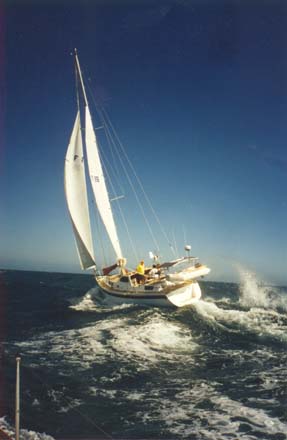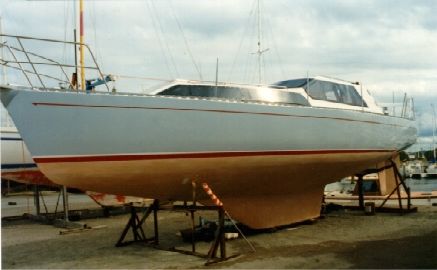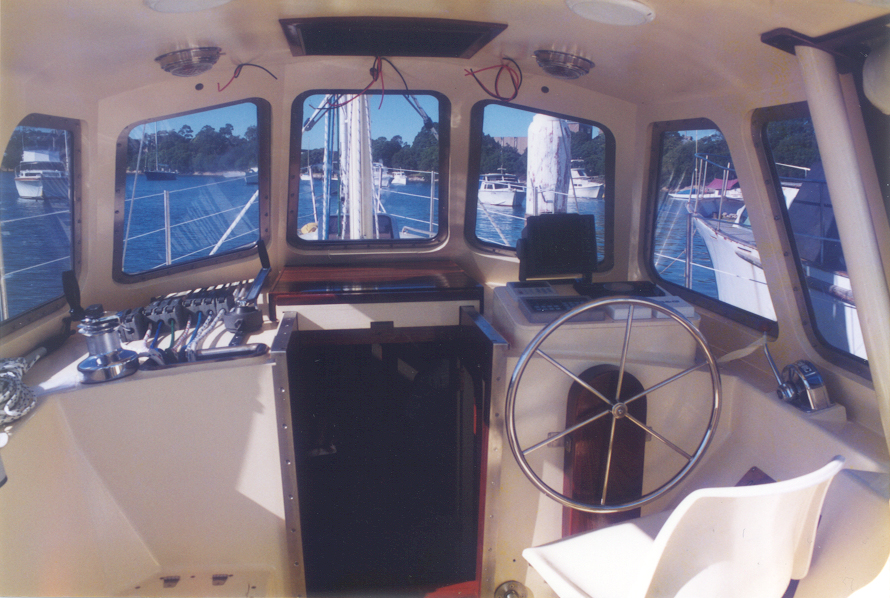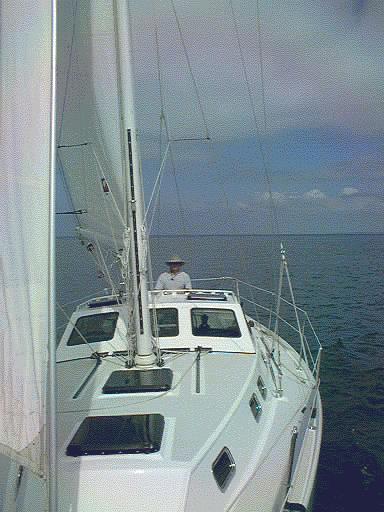


| L.O.A. | 12.20m | 40'0" |
| L.W.L. | 11.56m | 37'11" |
| Beam | 3.66m | 12'0" |
| Draft | 1.60m | 5'3" |
| Dspl | 11,570kg | 11.4T |
| SAIL AREA | ||
| Main | 35.6sq m | 383sq ft |
| Genoa | 50.6sq m | 545sq ft |
| Yankee | 31.0sq m | 333.7sq ft |
| Staysail | 12.0sq m | 129.2sq ft |
The R400 was the first of the Radford 1000 Series steel cruising yachts to be designed and it introduced a new, more modern style for a steel cruising yacht.

The R400 can be assembled from a Plasma cut kit. The Steel Kit Construction section describes the characteristics of the R400 hull, general design considerations, plus assembly and contents of the kits.
The range of design and kit options for the round bilge R400 kit yachts include centre cockpit and pilot house layouts; a 2.14m fin keel and a 1.6m shallow draft keel.

The accommodation drawings give an indication of what will easily fit into the space available. As the accommodation does not contribute to the structural strength of the yacht it can be easily altered to suit the owner's requirements. Tanks are mostly located below the cabin sole with more space available on the pilot house version. Both layout drawings show comfortable, wide settees with angled backrests. The pilot house is designed so that you can see out the windows whether seated or standing. The galleys are large with plenty of stowage. The forward vee berths can be converted to a double or, built as single upper and lower berths.

The pilot house version has large lazarettes with good access to the steering gear and gas bottle stowage under the aft deck. There is an optional watertight bulkhead between the lazarette and the accommodation which would give added safety. The centre cockpit layout has smaller aft lockers which can be accessed from on deck or below. Both have boarding platforms incorporated into the transom and an anchor locker forward of the collision bulkhead.
The centre cockpit and pilot house use conventional companionway boards. Fixed or soft dodgers, or a combination, are used for weather protection on the centre and aft cockpit versions while the pilot house has a cuddy cabin extension on the house.
The keel stepped double spreader rig can be used as either a sloop or cutter. The cutter would be favoured for cruising with the staysail becoming the storm jib when required. On the pilot house version the boom is angled up so that the mainsail can be sheeted on the house top leaving the cockpit clear.
| Waterline | Displacement | Loading | ||
|---|---|---|---|---|
| 25mm (1") Up | 10,917kg | 24,068lb | 0 | 0 |
| @ D.W.L. | 11,570kg | 25,507lb | 653kg | 1,440lb |
| 25mm (1") Down | 12,185kg | 26,863lb | 1,268kg | 2,795lb |
| 50mm (2") Down | 12,839kg | 28,305lb | 1,922kg | 4,237lb |
| 75mm (3") Down | 13,504kg | 29,770lb | 2,587kg | 5,700lb |
| 100mm (4") Down | 14,179kg | 31,259lb | 3,262kg | 7,190lb |
The R400 has good volume and the carrying capacity required for a cruising yacht. The following information shows the range of loading and changes in waterlines.
An effort should be made to build and load the yacht within the figures recommended. Overbuilding or adding any unnecessary weight during construction and fitout will detract from optimum loadings.
The hull structure is designed to the A.B.S. Guide for Offshore Racing Yachts and has A.B.S. Plan Approval. It is basically the same for both layouts with minor variations to floor heights and the engine positions.
Hull frames and floors are spaced at 600mm forward of midships and 750mm aft. Regularly spaced stringers allow for the use of 4mm hull plating. The frames, backbone and keel base are cut from 8mm plate; the floors, keel plating skeg, collision bulkhead, deck and house beams etc are 4mm plate; while the deck, house and cockpit plating are all 3mm. Total steel weight for the plates in the kit - including the hull plates, M.S. flatbar stringers, capping, tubes etc - comes to approximately 6.5T.
| S/L Ratio | Speed - knots | SHP |
|---|---|---|
| 1.00 | 6.16 | 23.35 |
| 1.10 | 6.77 | 31.08 |
| 1.20 | 7.39 | 40.36 |
| 1.3 | 8.01 | 51.31 |
| 1.34 (maximum) | 8.25 | 56.19 |
The maximum hull speed of the R400, at Speed / Length Ratio (S/L) = 1.34, is 8.25 knots. An efficient cruising speed is at S/L = 1.1, or 6.77 knots. The list shows the required shaft horsepower (SHP) for different speeds at 12,877kg (28,330lb) displacement. Note the rapid increase in required SHP (hence fuel consumption) for small gains in speed.
Based on a speed requirement, select an engine which - running at an optimum RPM - will give the required SHP for that speed.
The combination of the rig and hull shape will ensure good sailing performance while the airy accommodation space and the strength of the steel hull gives a safe, comfortable offshore cruising yacht.